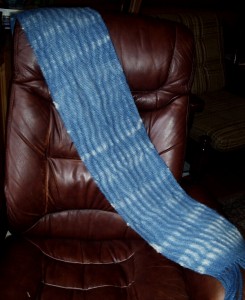I did not know that there was actually a day named “blue Monday” but apparently today’s the day. As part of today, I would like to share with you part of the journey that interested me in natural dyes, and particularly woad indigo. The journey spans many angles, and today the focus will be on the angle that is most “blue:” the pollution of synthetic indigo. This aspect was partially covered in the article Why Indigo is a Different Natural Dye.

Where the journey began
What sparked my focus on woad indigo was researching the problem that my science fair project needed to address. If dye is dye, there is no problem, and what is the use of woad indigo? But, not all dyes are created, or formatted, equal. Synthetic indigo is not equal to woad indigo in terms of complexity, sustainability, or eco-friendliness. Woad indigo comes from a plant, and has the possibility to be extracted without chemicals. Synthetic indigo is a chemical soup made from aniline, formaldehyde, and hydrogen cyanide. These chemicals are all carcinogenic.
Problems of synthetic indigo
My “problem shock” came when, I discovered that synthetic indigo is one of the most widely used, and most polluting synthetic dyes in the clothing industry. Synthetic indigo is carcinogenic, and was used as a food colouring until recently. In 2007 when I first did the research, Nestles refrained from saying what their blue candies were dyed with – leaving one to assume it was chemical indigo. Before synthetic food colouring names were taken off labels, in 2007/2008, I noticed that Ginger ale listed “FD&C blue #2” as the colouring agent, this colour is synthetic indigo.
Update: Now in 2018 there are fewer synthetic dyes being used in food processing. However, the polluting factor of synthetic and chemical dyes is still widespread in the clothing industry.
Benefits of Woad indigo
In contrast to the multitude of problems presented by synthetic indigo, woad indigo is amazing. I can grow it successfully in my zone three, marginal range land conditions. Extraction takes only an hour, and the waste water can be dumped without fear of putting toxins in the soil.
When dyeing with woad indigo, the colour is complex and varied. There are multiple “indigo colors” within the natural indigo dye. Natural indigo is not confined to a single dye molecule like synthetic indigo. The woad indigo sometimes leans toward purple, other times a pure blue, and other times towards green. These color variations have too many factors to predict.
Other natural indigo is also amazing. I prefer woad indigo because I grow it, and don’t have to import it. This plant is an amazing bee attractant in the second year flowering. Woad’s deep taproot can help breakup clay soils. The amendments, like mulch, that help the woad plant, attract worms and increase the fertility of the ground for the next rotational crop.
However, woad is a plentiful seed producer, so it is recommended to uproot the plants before the seed sets. If too much seed sets, it can always be used for direct contact dying.
A Problem with Woad Indigo
However, woad has one problem. Woad is classed as a noxious weed in the southwestern US States. This is including California, Utah, and Washington among other states. Before ordering woad seed, if you are in the US, please check the noxious weed website for your area. Before ordering, or planting seed make sure Woad (Isatis tinctoria) is not one of the noxious weeds listed.
If you are in one of those states, and can locate wild woad near you go ahead and harvest it. If woad’s an noxious weed you have a good excuse to find the woad and do extreme indigo extractions!
Back to You
What is your adventure with natural indigo? Have you ever used natural woad indigo? I would love to hear your story, leave a comment.